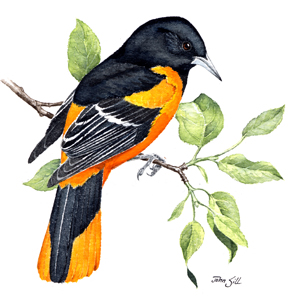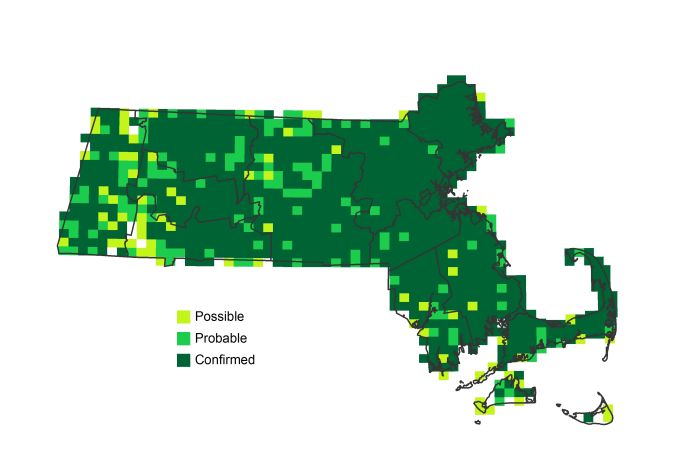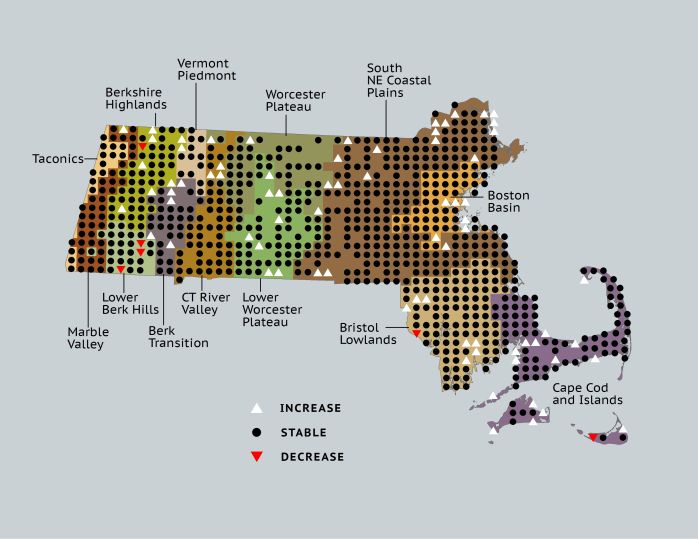Breeding Bird Atlases (BBA)
Find a Bird
Baltimore Oriole
Icterus galbula

Nearly ubiquitous and likely increasing
Action/monitoring needed

“To hear an Oriole sing / May be a common thing, / Or only a divine.” – Emily Dickinson, “Part Two: Nature”
The whistled caroling of a Baltimore Oriole delights the ear during the spring and summer when these handsome birds return to Massachusetts for the breeding season. Baltimore Orioles are so named because their orange-and-black plumage recalls the heraldic colors of the Barons of Baltimore, who were the proprietors of colonial Maryland. This species has made itself at home alongside humanity throughout the eastern United States, and Massachusetts is no exception. The species has persisted in Massachusetts despite periods of widespread deforestation by favoring orchards, shady suburban avenues, and clusters of trees left standing along the edges of rivers and lakes.
Historic Status
Bird gawkers of old delighted every spring in the return of the Golden Robin, Fire-bird, Hang-nest, or, indeed, the Fire-hang-bird. “The Baltimore Oriole,” wrote William Peabody in 1839, “is perhaps the most splendid of all our summer visitors, and is admired, both for the richness of its plumage, and the full-hearted sweetness of its song” (Peabody, 1839). It has been a harbinger of spring since the days before European colonization. “The coming of the Baltimore Oriole to the north is always an event to be welcomed with joy,” wrote Edward Howe Forbush in 1927. “Ever in New England this beautiful, elegantly formed bird is associated with blooming apple orchards, and with peach and cherry blossoms.”
Atlas 1 Distribution
In Atlas 1 there were very few places in the state where Baltimore Orioles could not be found, and they eked out 83% block occupancy statewide. They were widespread in the Berkshires, though the highest elevations of the Berkshire Highlands were conifer dominated and thus less attractive to orioles. The species’ preference for river corridors was evident from the considerable breeding activity in the Connecticut River Valley, and they had 100% block occupancy in the Marble Valleys. In the eastern regions of the state, the breeding distribution of the Baltimore Oriole was weighted toward the Coastal Plains, and weighted away from the Cape and Islands, but even there block occupancy was 64%.
Atlas 2 Distribution and Change
As with many other species with an expanding breeding footprint, the Baltimore Oriole has grown in block occupancy by persisting in Atlas 1 blocks while also occupying new blocks. This increase has helped the species reach statewide block occupancy rates of 93%, with region-specific occupancy rates falling below 90% only in the Taconics, Lower Berkshire Hills, and Cape Cod and the Islands ecoregions.
Atlas 1 Map

Atlas 2 Map

Atlas Change Map

Ecoregion Data
Atlas 1 | Atlas 2 | Change | ||||||
Ecoregion | # Blocks | % Blocks | % of Range | # Blocks | % Blocks | % of Range | Change in # Blocks | Change in % Blocks |
Taconic Mountains | 15 | 93.8 | 1.9 | 20 | 80.0 | 2.1 | 0 | 0.0 |
Marble Valleys/Housatonic Valley | 39 | 100.0 | 4.9 | 39 | 100.0 | 4.0 | 0 | 0.0 |
Berkshire Highlands | 43 | 78.2 | 5.4 | 53 | 96.4 | 5.5 | 8 | 15.1 |
Lower Berkshire Hills | 26 | 92.9 | 3.3 | 24 | 77.4 | 2.5 | -3 | -11.1 |
Vermont Piedmont | 16 | 94.1 | 2.0 | 17 | 100.0 | 1.8 | 0 | 0.0 |
Berkshire Transition | 30 | 78.9 | 3.8 | 39 | 97.5 | 4.0 | 5 | 16.1 |
Connecticut River Valley | 51 | 91.1 | 6.4 | 61 | 93.8 | 6.3 | 3 | 6.3 |
Worcester Plateau | 55 | 70.5 | 6.9 | 87 | 98.9 | 9.0 | 5 | 10.4 |
Lower Worcester Plateau | 58 | 78.4 | 7.3 | 79 | 98.8 | 8.2 | 7 | 13.0 |
S. New England Coastal Plains and Hills | 239 | 88.5 | 29.9 | 278 | 98.2 | 28.8 | 18 | 8.0 |
Boston Basin | 46 | 82.1 | 5.8 | 53 | 94.6 | 5.5 | 6 | 10.9 |
Bristol and Narragansett Lowlands | 95 | 89.6 | 11.9 | 107 | 93.9 | 11.1 | 6 | 5.9 |
Cape Cod and Islands | 87 | 64.0 | 10.9 | 107 | 74.3 | 11.1 | 14 | 11.7 |
Statewide Total | 800 | 82.6 | 100.0 | 964 | 93.0 | 100.0 | 69 | 8.3 |
Notes
Despite this apparent stability of their breeding footprint, the Breeding Bird Survey (BBS) shows significant declines in Baltimore Orioles' abundance for Massachusetts, the New England/Mid-Atlantic Region, and the Eastern US overall. They fall into our “whispering bird” category – those species with a demonstrated stable or increasing breeding footprint from Atlas 2 data, but also a demonstrated decline in abundance from the BBS. This drives our final assessment that this is a species with a need for further monitoring and conservation action.



